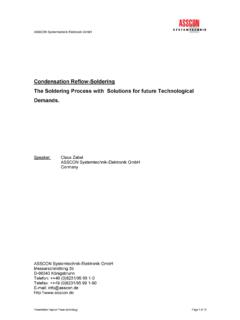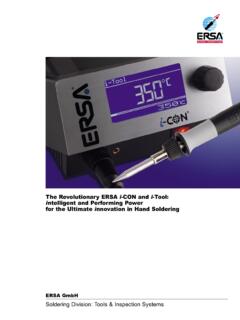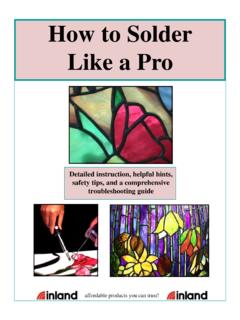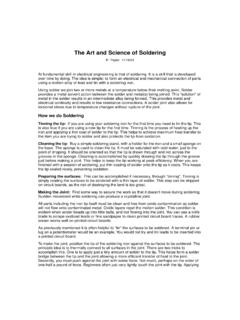Transcription of Thermal Profiling: A Practical Approach to Reflow Profiling
1 Thermal Profiling : A Practical Approach to Reflow Profiling By , Indium Corporation In the lead-free era, Thermal Profiling has a critical role in the SMT assembly process. We discuss the Profiling , tools, Practical issues, and inspection methods of golden boards, and related tools. As the process window narrows, Profiling equipment and/or thermocouple (TC) errors must be taken into consideration. In addition, the accuracy and attachment method of the thermocouple will significantly impact critical assemblies. A Thermal profile is an important record, process tool, and history of PCB assembly an electrocardiogram (ECG) of your solder process. Profiling requires in-depth process knowledge and practice. Moreover, it is an art. Reflow soldering Profiling warrants more discussion in detail. Thermal Profile A Thermal profile is a time versus temperature graph of the soldering process. Profiling is the process to determine the proper time duration and temperature a PCB assembly (PCBA) must endure throughout the Reflow cycle1 (applicable to oven Reflow and wave soldering , as well as adhesive curing).
2 During mass soldering , all solder joints must reach the minimum soldering temperature and duration. The minimum soldering temperature is the temperature necessary to ensure metallurgical bonding of the solder alloy and base metals to be Objectives of Profiling The main objectives of Profiling are to make certain the desired soldering temperature is achieved, which ensures that proper wetting occurs and adequate intermetallic compounds are formed; to make certain the desired adhesive curing temperature is achieved, which ensures adequate adhesive strength; and finally to ensure that components and PCBs are not damaged due to excessive temperature or excessive ramp Profile Types Baseline profile. This profile is the start-up profile for your process, which will be given by the oven and/or solder paste manufacturer. It can also be a rough profile as defined by the process engineer. Generally, the baseline profile is obtained by running a bare PCB through the soldering process.
3 Product board profile. This is the real profile of a PCB assembly. It is necessary to establish a product profile for each PCB assembly because each assembly will have a different Thermal mass and laminate. This profile can be used to establish an optimized defect-free process and process record. Also, in the case of defect analysis, you can run a product profile by using a product profile board, a golden board. If you're in the EMS industry, ask the OEM to provide an assembled board and reserve another after initial build. Calibration Profile: Once you establish a proven process with a good yield, a calibration profile board can be used for Profiling . This calibration profile verifies the condition of the oven and will save the Golden Profile board life expectancy. You can define the correlation graph by using the product profile as a baseline. Generally, the calibration profile will be the Published by SMT Magazine, March 2009 Designated one of SMT Magazine s Most Popular Papers for 2009 hottest.
4 If variations are observed in the calibration profile, you may want to review the oven condition and run a product profile to reconfirm. The calibration board is a duplicate board that has a standard dimension and a thick laminate (or durastone sheet) without any Thermal mass. There should be a minimum of two thermocouples to read the laminate surface temperature and air temperature. Tools and Equipment Profiler. A profiler is a data-recording device that will measure, record, transfer/decode, and display a time versus temperature graph with the help of suitable software. The person who uses the profiler must understand the accuracy/limits of error, which are generally C. There are three types of profilers: product profilers, machine profilers, and real-time continuous profilers or monitors. Product profilers are widely used to determine the time and temperature history of a PCB assembly. Thermocouple. A thermocouple is a thermoelectric device used to measure the accuracy of the temperature.
5 It comprises two dissimilar metals joined together at one end. When the junction of the two metals is heated or cooled, a voltage is produced that correlates back to the temperature. There are many types of thermocouples available; generally, type K is used in SMT applications. Type K has a nickel-chromium positive lead and nickel-aluminum negative lead. Type K TCs have a wide operating range, from -200 to +1250 C, and an accuracy of approximately C. A thermocouple bead should be welded. Commercial thermocouples are manufactured on expensive machinery using a capacitive-discharge technique to insure It is not advisable to solder the two thermocouple wires to make the junction because this adds extraneous materials to the thermocouple junction, which will affect the measurement. Simply twisting two wires also is not recommended. If the measurement is not accurate, you will not establish a correct Thermal profile. This makes measuring tools and equipment imperative.
6 For small chip components and CSPs, the bead diameter is an important consideration. A 36 AWG (5-mil) bead diameter is recommended for Profiling , but a 30 AWG (10-mil) bead diameter also can be used. TC attaching materials. High-temperature solder doesn't melt during normal Reflow , which the board will be subjected to, so this is the right material to use when attaching the TCs. There are some Practical challenges with high-temperature solder TC attachment that will be discussed further. Pb95Sn5 flux-cored (high-temperature-capable flux) solder wire with a melting point of 312 C is commonly used for this purpose. Aluminum tape is thermally conductive and can be used to attach TCs more quickly. It will not stand up to multiple profiles. Polyimide tape is a mildly thermally conductive tape, which is sensitive to high heat. For this reason, this method is not recommended for TC attachment; it frequently delaminates from the PCB.
7 Thermally conductive adhesives, or SMT adhesives, can be used to attach TCs via a cure on Published by SMT Magazine, March 2009 Designated one of SMT Magazine s Most Popular Papers for 2009 the board. Since SMT adhesives can withstand wave- soldering temperatures, they can withstand multiple Reflow temperatures. To determine the repeatability of given TC attachments in a factory setting, conduct your own experiments and choose the TC attachment process that best suits your needs. Attachment There should be a minimum of four thermocouples on the board: an air-temperature TC off the front of the board; one at the hottest portion of the PCB; one at the coolest area; and one on any temperature-sensitive components, such as plastic-encapsulated packages. The hottest area on a PCB assembly is bare copper pads or small passives. The coolest areas are underneath the plastic/ceramic active packages and/or SMT coil/transformer leads.
8 The hottest area will heat up quickly and then cool down before the coolest area does. Sometimes, a thermocouple is attached on the plastic package to measure its body temperature. For a detailed Thermal profile, a minimum of 5 to 6 thermocouples is required. The air-temperature TC measures the ambient temperature during the Reflow process to ensure machine capability. To prepare a profile board for product board Profiling , you will need a completely assembled board. If the product has two sides, you have to establish a bottom-side profile (one side populated) and top-side profile (both sides of the PCB populated) separately. To attach the TC to a resistor or capacitor (any soldered joint), you need to remove the old solder from the area where the TC has to be attached; if it is not removed, the solder will melt during Profiling and interfere with the TC bead. After removing the old solder, attach a TC with either high-temperature solder wire or SMT adhesive.
9 Ensure that the bead is firmly guided with Kapton tape and is touching the desired area prior to applying glue or soldering . If you don't hold/guide the TC bead properly (without strain), it may lift or displace when soldered. During soldering , iron and wire may touch the bead and cause it to lift or displace (Figure 1). Never solder/attach a TC with normal soldering wire, which will melt during the Reflow process. For array packages, an embedded/destructive method is used. Generally, BGA and other array packages are difficult to profile. To attach a TC to a BGA ball, a hole can be drilled from the bottom side through the PCB, ensuring it has not drilled thru the BGA ball/die. Attach the TC onto the center of the array, as that area will be coolest. It will take longer to melt the paste and balls in the middle area than those on the peripheral. A common method to attach the TC to the BGA is to drill the required hole at the array package site in a bare PCB, then paste print the PCB.
10 Initiate an underside cleaning prior to printing the next board, because the paste that is supposed to print on the drilled site has not yet deposited and will be hanging under the stencil. After completing the assembly and soldering , attach the TC from the bottom side. Now the TC bead will be able to touch the solder ball and pad interface (pad has drilled off) without fail. Attach the TC with high-temperature solder wire or SMT adhesive; adhesive is more convenient here. Make sure the bead touches the ball and not the sides of the drilled hole. Refer to Figure 2. The drilled holes should not be big: approximately mm for small TC beads. In the case of an assembled PCB, you may remove the BGA/CSP to drill a hole and reassemble with a rework process. Later, the TC can be attached as explained above. Published by SMT Magazine, March 2009 Designated one of SMT Magazine s Most Popular Papers for 2009 TC Attachment Inspection How do profiler technicians ensure that thermocouples are attached to the right interface of the pad and component/solder bump?












